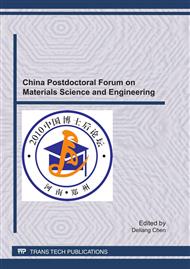[1]
H.W. Kroto, J.R. Heath, S.C. O'Brien, R.F. Curl and R.E. Smalley: Nature Vol. 318 (1985), p.162.
Google Scholar
[2]
S. Iijima: Nature Vol. 354 (1991), p.56.
Google Scholar
[3]
A. Krishnan, E. Dujardin, M.M.J. Treacy, J. Hugdahl, S. Lynum and T.W. Ebbesen: Nature Vol. 388 (1997), p.451.
DOI: 10.1038/41284
Google Scholar
[4]
T. Nakamura, Y. Yamada and K. Yano: Micropor. Mesopor. Mater. Vol. 117 (2009), p.478.
Google Scholar
[5]
H. -T. Kim, D.J. You, H. -K. Yoon, S.H. Joo, C. Pak, H. Chang and I. -S. Song: J. Power Sources Vol. 180 (2008), p.724.
Google Scholar
[6]
W. Wang, K. Yang, J. Gaillard, P.R. Bandaru and A.M. Rao: Adv. Mater. Vol. 20 (2008), p.179.
Google Scholar
[7]
R.C. Tenent, T.M. Barnes, J.D. Bergeson, A.J. Ferguson, B. To, L.M. Gedvilas, M.J. Heben and J.L. Blackburn: Adv. Mater. Vol. 21 (2009), p.3210.
DOI: 10.1002/adma.200803551
Google Scholar
[8]
S.B. Yang, X.L. Feng, L.J. Zhi, Q. Cao, J. Maier and K. Müllen: Adv. Mater. Vol. 21 (2009), p.1.
Google Scholar
[9]
P. Karandikar, K.R. Patil, A. Mitra, B. Kakade and A.J. Chandwadkar: Micropor. Mesopor. Mater. Vol. 98 (2007), p.189.
Google Scholar
[10]
J.F. Lin, V. Kamavaram and A.M. Kannan: J. Power Sources Vol. 195 (2010), p.466.
Google Scholar
[11]
Y.H. Ng, S. Ikeda, T. Harada, T. Sakata, H. Mori, A. Takaoka and M. Matsumura: Langmuir Vol. 24 (2008), p.6307.
Google Scholar
[12]
M. Kim, S.B. Yoon, K. Sohn, J.Y. Kim, C. -H. Shin, T. Hyeon and J. -S. Yu: Micropor. Mesopor. Mater. Vol. 63 (2003), p.1.
Google Scholar
[13]
Z.H. Wen, Q. Wang, Q. Zhang and J.H. Li: Electrochem. Commun. Vol. 9 (2007), p.1867.
Google Scholar
[14]
Z.X. Yan, H. Meng, L. Shi, Z.H. Li and P.K. Shen: Electrochem. Commun. Vol. 12 (2010), 689.
Google Scholar
[15]
Z.X. Yan, Z.F. Hu, C. Chen, H. Meng, P.K. Shen, H.B. Ji and Y.Z. Meng: J. Power Sources Vol. 199 (2010), 7146.
Google Scholar
[16]
Z.S. Lou, Q.W. Chen, W. Wang, Y.T. Qian and Y.F. Zhang: Angew. Chem. Int. Ed. Vol. 115 (2003), 4539.
Google Scholar
[17]
J.X. Huang, Y. Xie, B. Li and Y.T. Qian: Adv. Mater. Vol. 12 (2000), p.808.
Google Scholar
[18]
J.F. Chen, W. Qian, Y. Ye and Q.W. Chen: J. Phys. D: Appl. Phys. Vol. 39 (2006), p.1472.
Google Scholar
[19]
W. Qian, L.Z. Wei, F.Y. Cao and Q.W. Chen: Carbon Vol. 44 (2006), p.1303.
Google Scholar


